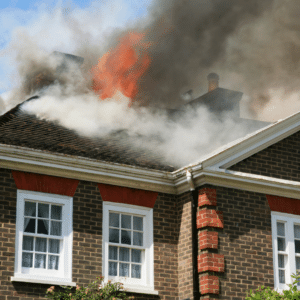Ensuring the safety of your home in wildfire-prone areas requires a comprehensive understanding of advanced roof maintenance techniques. Beyond the basics, these strategies offer added protection and peace of mind.
To safeguard your home against wildfires through advanced roof maintenance, consider elevating eaves and securing vents with ember-resistant mesh. Regular chimney maintenance, relocating flammable attic materials, and assessing solar panel fire resistance are crucial. Additionally, use fire-resistant roof decking, create firebreaks, and establish a consistent roof maintenance schedule. These advanced techniques, combined with the basics, provide a comprehensive approach to fortify your home against wildfires.
Advanced Roof Maintenance Techniques
Elevating Eaves and Securing Vents
In wildfire-prone regions, safeguarding your home begins with advanced roof maintenance techniques such as elevating eaves and securing vents with ember-resistant mesh. Airborne embers pose a significant threat in these areas, and elevating the eaves, which are the overhanging edges of the roof, is a crucial step. This involves creating a gap or barrier between the roof and the eaves to prevent embers from getting trapped and igniting flammable materials within your home. Consulting a professional for guidance is wise, as they can recommend the most suitable elevation method, such as eave shields made of non-combustible materials.
Additionally, securing roof vents with ember-resistant mesh is vital. This specialized mesh allows for ventilation while preventing embers from entering. Professional installation and regular inspections ensure the effectiveness of these measures, making your home more resilient to wildfire threats.
Regular Chimney Maintenance
While chimney care might not be top of mind in roof maintenance, it’s a vital aspect of overall home safety, particularly in wildfire-prone regions. Neglected chimneys can become serious fire hazards, as embers can travel long distances in such areas.
In wildfire-prone regions, embers are a significant concern. Poorly maintained chimneys can provide an entry point for embers, potentially leading to a roof fire. Routine chimney inspections and maintenance help keep your chimney sealed against ember intrusion.
Additionally, chimneys tend to accumulate creosote over time, a highly flammable substance that can ignite when exposed to heat. Regular maintenance, including creosote removal, minimizes the risk of chimney fires that could impact your roof. Incorporating chimney care into your roof maintenance routine not only addresses common issues but also enhances your home’s defense against wildfires, ensuring its safety and longevity.
Relocating Flammable Attic Materials
One often overlooked yet crucial aspect of roof maintenance is relocating flammable attic materials. Many homeowners utilize their attics for storage, a practice that can unwittingly create a significant fire hazard. Embers from wildfires have the potential to infiltrate even the smallest openings in your roof, gaining access to the attic space. Once inside, they can ignite any flammable materials they encounter, initiating a fire that may spread to the rest of your home.
To mitigate this risk and fortify your roof’s fire protection capabilities, consider these preventive measures:
- Regular Assessment: Periodically assess your attic for the presence of flammable materials. Identify and segregate items that pose a fire risk.
- Safe Storage: Store flammable materials in designated, fire-resistant containers or cabinets. This adds an extra layer of protection in case embers breach your roof.
- Ember-Resistant Vents: Install ember-resistant vents in your attic to prevent ember intrusion in the first place.
Relocating flammable attic materials and taking these precautions can significantly reduce the potential for a roof-related fire, making your home safer and more resilient to wildfire threats.
Assessing Solar Panel Fire Resistance
Solar panels, valued for their environmental advantages, are a popular choice for homeowners. Yet, in wildfire-prone areas, these panels can pose an unexpected fire hazard. Solar panels, typically installed on rooftops, are vulnerable to embers or flames during wildfires. Without adequate protection, they can become ignition sources, endangering your home. Ensuring the fire resistance of your solar panel system is essential. To assess your solar panels consider these:
- Consult a Professional: Seek guidance from a certified solar panel technician or installer who understands local fire safety requirements.
- Evaluate Panel Materials: Inspect the materials used in your solar panels, opting for fire-resistant options when possible.
- Placement and Spacing: Ensure panels are well-positioned and spaced to minimize fire risk.
- Ember-Resistant Features: Consider incorporating ember-resistant features to prevent ember intrusion.
- Regular Inspections: Implement routine inspections to check for damage or debris accumulation that could compromise fire resistance.
Assessing and enhancing the fire resistance of your solar panel system is an essential part of advanced roof maintenance, keeping your home safe in wildfire-prone regions while reaping the benefits of solar energy.
Fire-Resistant Roof Decking
The selection of roofing materials plays a pivotal role in enhancing your home’s fire resistance. Fire-resistant roof decking materials are specifically engineered to withstand high temperatures and thwart ignition, significantly reducing the risk of fires originating from your roof.
In wildfire-prone regions, where airborne embers can pose a substantial threat, having a fire-resistant roof can be a game-changer. It serves as a crucial line of defense, preventing the rapid spread of fires from neighboring areas or embers that may land on your roof.
When opting for fire-resistant roof decking, consider these factors:
- Material Composition: Look for materials explicitly designed to resist fire, such as Class A roofing materials, which have the highest fire resistance rating.
- Local Codes and Regulations: Familiarize yourself with local building codes and regulations related to roofing materials. Compliance with these standards is essential for safety and legal compliance.
- Professional Consultation: Consult with roofing professionals who have experience in wildfire-prone areas. They can recommend suitable fire-resistant materials based on your location and specific needs.
By choosing fire-resistant roof decking, you add a layer of protection to your home, mitigating the risk of roof-related fires. This choice not only enhances safety but also contributes to the advanced roof maintenance necessary for the long-term well-being of your home, particularly in regions prone to wildfires.
Creating Effective Firebreaks
The threat of wildfires is ever-present in certain areas, and when they strike, their speed and intensity can be overwhelming. Firebreaks act as crucial buffers, interrupting the wildfire’s path and providing a critical line of defense for your home.
Elements of Effective Firebreaks:
- Vegetation Clearance: Firebreaks are designed to eliminate or significantly reduce vegetation, cutting off the fire’s fuel source.
- Optimal Width: The width of a firebreak matters; it should be wide enough to effectively impede the fire’s advance.
- Strategic Placement: Proper positioning is crucial; firebreaks should intercept the approaching fire and divert its path away from your home.
- Regular Maintenance: Ongoing upkeep is vital to keep firebreaks clear and ready for action.
By creating well-planned and well-maintained firebreaks around your property, you significantly enhance your home’s resilience to wildfires.
Establishing a Consistent Roof Maintenance Schedule
To guarantee the durability and reliability of your roof’s fire-resistant components, it’s essential to establish a consistent roof maintenance schedule. Regular inspections and prompt repairs play a pivotal role in safeguarding your home.
Roof maintenance extends the life of your roof and ensures its continued fire-resistant capabilities. Neglecting maintenance can lead to vulnerabilities that compromise the effectiveness of your roof in fire-prone areas. Here are maintenance activities that you can do:
- Regular Inspections: Schedule routine inspections to assess the condition of your roof, including fire-resistant materials and features.
- Timely Repairs: Address any issues promptly, whether it’s damaged roofing materials, compromised fire-resistant barriers, or other vulnerabilities.
- Cleaning and Clearing: Keep your roof free from debris, such as leaves and branches, which can become fuel during a fire.
- Gutter Maintenance: Ensure your gutters are clear and functioning correctly, as they play a role in fire prevention by preventing ember buildup.
- Review your Insurance Policy: To ensure it adequately covers wildfire roof damage. Understanding your coverage and making necessary adjustments can provide you with peace of mind, knowing your home is well-protected in the event of a wildfire.
Maintaining a consistent roof maintenance schedule can uphold your investment in fire-resistant roofing materials, contributing significantly to your home’s safety and resilience in wildfire-prone areas.
Can I perform these advanced roof maintenance techniques myself, or do I need to hire professionals?
While some of these advanced techniques can be tackled by experienced homeowners, it’s often advisable to consult with professionals, especially in wildfire-prone areas where safety is paramount. Elevating eaves and securing vents, for instance, may require specialized tools and expertise. Chimney maintenance and assessing solar panel fire resistance are tasks best handled by qualified technicians. When in doubt, it’s always a good idea to seek professional guidance to ensure the job is done correctly and safely.
By combining these advanced techniques with the basics of roof maintenance, you can significantly enhance the safety and protection of your home. With these measures in place, you can enjoy peace of mind, knowing that your home is well-prepared to withstand the challenges posed by wildfires. Schedule a roofing inspection today with Just Roofs and Gutters and ensure your home is well-prepared to withstand wildfires and other threats. Your safety and peace of mind are worth it.





